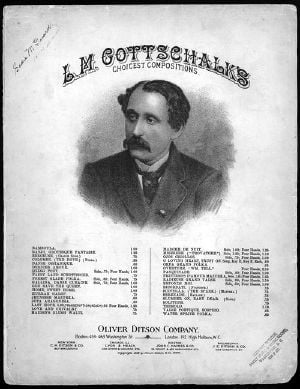Difference between revisions of "Louis Moreau Gottschalk" - New World Encyclopedia
Cheryl Lau (talk | contribs) |
Cheryl Lau (talk | contribs) |
||
| Line 27: | Line 27: | ||
* Kunst der Fuge: [http://www.kunstderfuge.com/gottschalk.htm Louis Moreau Gottschalk - MIDI files (piano works)] | * Kunst der Fuge: [http://www.kunstderfuge.com/gottschalk.htm Louis Moreau Gottschalk - MIDI files (piano works)] | ||
| − | [[Category: | + | [[Category:Music]] |
| − | + | [[Category:Art, music, literature, sports & leisure]] | |
| − | |||
| − | |||
| − | [[Category: | ||
| − | |||
| − | |||
| − | |||
| − | |||
| − | |||
| − | |||
| − | |||
| − | |||
| − | |||
| − | |||
| − | |||
| − | |||
Revision as of 03:32, 9 January 2007
Louis Moreau Gottschalk (May 8, 1829 – December 18, 1869) was an American composer and pianist, best known as a virtuoso performer of his own romantic piano pieces. Although he is regarded as an American composer and musician, he spent most of his working career outside of the United States.
Biography
Gottschalk was born of a Jewish businessman from London and a white Creole Haitian in New Orleans, where he was exposed to a wide variety of musical traditions. His family lived for a time in a tiny cottage at Royal & Esplanade in the Vieux Carré, and Louis subsequently moved in with relatives at 518 Conti Street. His Grandmother Buslé and his nurse Sally were both natives of Saint-Domingue. He played the piano from an early age and was soon recognized as a wunderkind by the New Orleans bourgeois establishment. In 1840, he gave his informal public debut at the new St. Charles Hotel.
Only two years later, he left the United States and sailed to Europe, realizing that a classical training would be required to fulfill his musical ambitions. The Paris Conservatoire, however, initially rejected his application, and Gottschalk only gradually gained access to the musical establishment through friends.
Upon his return to the United States in 1853, Gottschalk travelled extensively; a lengthy trip to Cuba in 1854 marking the beginning of a series of trips to Central and South America. By the 1860s, Gottschalk had established himself as the foremost pianist in the New World. Although born in New Orleans, he was a supporter of the Union cause during the American Civil War — and although he returned to his native city only occasionally for concerts, he always introduced himself as a New Orleanian. In 1865, he was forced to leave the United States as the result of what was regarded as a scandalous affair with a student at the Oakland Female Seminary.
He chose to again travel to South America, where he continued to give frequent concerts. During one of these concerts, in Rio de Janeiro on November 24, 1869, he collapsed, the result of a burst appendix. Much was made of the fact that, just before his collapse, he had finished playing his romantic piece Morte!! (interpreted as "she is dead"), although the actual collapse occurred just as he started to play his celebrated piece Tremolo.
Gottschalk never recovered from the collapse and three weeks later, on December 18, 1869, died at his hotel in Tijuca, Rio de Janeiro, Brazil. His remains were subsequently returned to the United States and are presently interred at the Green-Wood Cemetery in Brooklyn, New York. His burial spot was originally marked by a magnificent monument which has eroded considerably over the years, and the Green-Wood is actively seeking donations to restore the monument, the cost of which they estimate at $75,000 (http://www.green-wood.com/pdf/gottschalkp6to7.pdf).
Works
Gottschalk's music was very popular during his lifetime, and his earliest compositions created a sensation in Europe. Early pieces like "Media:Le Bananier" and "Bamboula" were based on Gottschalk's memories of the music he heard during his youth in Louisiana, and were regarded as magnificently exotic by the critics of the time. Throughout his life, Gottschalk used a variety of non-traditional, ethnically derived material for many of his compositions. Notable examples include the "Souvenir de Porto Rico" and "The Banjo, Grotesque Fantasie". These ethnic and national-character pieces are regarded as his finest and most important work.
Gottschalk was also very successful as a composer of more traditional salon music. Sentimental pieces like "The Dying Poet" were favorites of countless, mostly female, amateur pianists. His most famous work in this vein is "The Last Hope, Religious Meditation" which enjoyed a spectacular success during Gottschalk's life, and for several decades afterward. Most critics regard Gottschalk's salon compositions as dated, musically shallow and insignificant in comparison with his more distinctive American ethnic music. However, he is now beginning to be rediscovered as modern art music has become consistently more complex and disengaged from the listener. In this context, some of Gottschalk's work, such as the 13 minute opera "Cuban Country Scenes" retains a wonderfully innocent sweetness and charm.
External links
- A dedicated Gottschalk site
- Biographical sketch
- "Diary of a 'One-Man Grateful Dead'", Adam Kirsch, The New York Sun, June 7, 2006.
- Free Public Domain Scores by Gottschalk at IMSLP
Listening
- Art of the States: Louis Moreau Gottschalk five works by the composer
- Kunst der Fuge: Louis Moreau Gottschalk - MIDI files (piano works)
